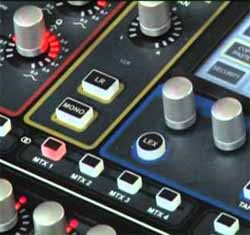Digital consoles have certainly changed the way our workflows and the ways we mix.
No more cumbersome large-frame analog consoles that take four or more stagehands to move and set up.
No more promoters and event planners crying about how much room said large-frame analog console and associated outboard drive and effects racks are occupying at front of house.
No more large, heavy analog snake cables to coil up at the end of the gig now that we can run a single coax, fiber or Cat cable for networking.
The “no more” list seems endless, but the initial buy-in to this digital revolution took some big bucks as early digital consoles were quite pricey.
As with electronic devices over time, prices come down and feature sets go up, with digital consoles being no exception. In fact, a new category of digital consoles sprung up a few years ago when manufacturers listened to those of us who didn’t necessarily want or need a large consoles for our small- to medium-sized gigs.
These “compact” units often offer most/all of the bells and whistles of their bigger siblings with the exception of reduced fader counts, or they may actually be different consoles altogether and offer a reduced feature set. Even with fewer features they still pack a punch and offer up way more processing than we ever had in our analog racks as well as more routing capabilities than a large-frame 48-channel analog console ever could.
The compact digital mixers we’re referring to here fall into the 16- to 32-channel size, but don’t let fader count or onboard inputs fool you, because many offer increased channel capabilities by using fader layers and adding additional stage I/O units. Some can even be cascaded together allowing desks to conveniently increase capabilities or even form a larger console.
Many of these smaller mixers aren’t skimping in the routing department either, as many have quite a few mix buses and matrix outputs. The same goes with processing and effects. Even the most miniscule units offer multiple effects and processing like compression and gating on each channel, again providing more capabilities than the largest tours had with analog desks just 10 or so years ago.
And if you don’t like the onboard effects and processing, many models offer the ability to integrate plug-ins that are software processors crafted to emulate the operation and results of modern or vintage outboard gear, and they can also be used to formulate new creations offering a different take on a particular effect or processor.
As we’re tasked to do more live recording, manufacturers have answered the call by providing a slew of recording options, including recording to USB, external hard drives and tablets, as well as multi-track recording to a DAW via a dedicated path like USB and FireWire or a digital network protocol like MADI or Dante. Not satisfied with the just recording the event, some of these consoles can be configured into a mix-down desk at the push of a button to deliver double duty as both a recording and live audio desk.
Topping it off, the majority of compact mixers can also be remotely operated via computer and/or tablet. Wired or wireless, these remote devices provide access to mix functions that allow users a user to move around the venue rather than being anchored to the control surface. Some even accommodate multiple tablets (or smart phones), allowing performers to control their own monitor mixes.
With all these capabilities and more, it’s no wonder that compact consoles are a big hit. Enjoy our Real World Gear Photo Gallery Tour of a variety of compact consoles.















